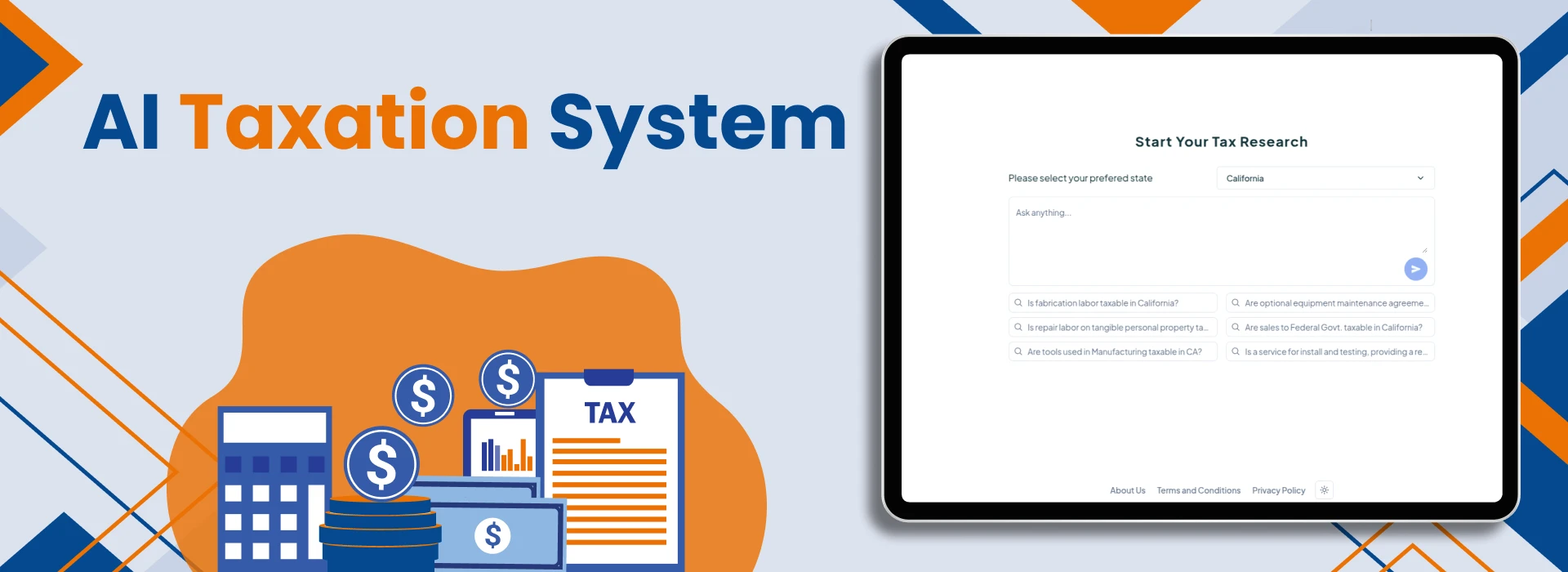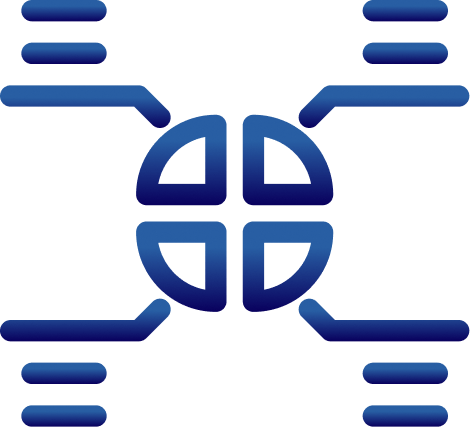AI-Taxation System
AI-Taxation System

About Client
Industry
Finance & Taxation
Location
USA
Industry
Finance & Taxation
Location
USA
Project Overview
A U.S. based enterprise struggled with the inefficiencies of manually searching for accurate and up-to-date tax information. Employees had to navigate multiple sources, often encountering outdated or inconsistent data, making compliance verification a time-consuming challenge. The company needed a centralized solution to streamline tax-related inquiries, reduce research efforts, and ensure regulatory accuracy.
Additionally, the system continuously learns and adapts to new tax regulations, ensuring businesses always have access to the most current information. This makes it a future-proof solution for enterprises navigating the complexities of taxation with confidence and efficiency.
Traditional Process
Before implementing the AI-Taxation System, employees had to rely on a manual approach to find tax-related information, which led to inefficiencies and inconsistencies. The traditional process involved:
01
Employees had to manually search for taxation-related updates and regulations across various platforms, such as government websites, financial news portals, legal documents, and tax advisory blogs. Since tax laws frequently change, staying updated requires constant monitoring of multiple sources.
02
Tax laws and regulations are often written in technical language, making it difficult for employees without specialized expertise to understand them. This required additional effort to interpret complex terms and ensure compliance.
03
Different sources might present taxation details in varying formats or with inconsistencies, employees had to cross-check data from multiple platforms to verify authenticity. This increased the chances of encountering outdated or conflicting information.
04
To minimize compliance risks, businesses often needed to consult tax professionals or financial advisors. This process was both time-consuming and costly, adding an extra layer of dependency on external expertise.
05
After gathering relevant information, employees had to document key taxation details manually. Maintaining accurate records required constant updates and organization, which was both labor-intensive and prone to human error.
06
Since taxation policies frequently change, relying on manual research increases the likelihood of missing critical updates. Any oversight in compliance could lead to penalties, incorrect tax filings, or financial setbacks for the business.
Challenges Faced
Here are the challenges users faced before implementing the AI-Taxation System, primarily due to inefficient and time-consuming searches for relevant tax information across multiple sources.
01
Finding relevant tax information required users to visit multiple government portals, financial blogs, and tax forums. This manual process was not only inefficient but also time-consuming, as users had to sift through vast amounts of data to locate specific details. The lack of a centralized source made research cumbersome, often delaying important financial decisions.
02
Tax regulations frequently change, and different sources often provide conflicting or outdated information. Employees had to manually compare details from multiple platforms, leading to confusion and a higher risk of relying on incorrect data for tax planning and compliance. This inconsistency made it difficult to ensure accuracy in financial reporting.
03
Tax laws are filled with technical terms and legal jargon, making them difficult to understand for individuals without specialized knowledge. Many users struggled to interpret taxation rules correctly, increasing the risk of errors in calculations and compliance. Misinterpretations could lead to incorrect filings, financial penalties, or missed deductions.
04
The slow and manual process of gathering, verifying, and understanding tax-related information caused delays in financial decision-making. Businesses that rely on accurate tax insights for budgeting, forecasting, and compliance face inefficiencies, sometimes resulting in missed deadlines or unexpected financial liabilities.
05
Locating past tax records or previously resolved queries was challenging, as there was no easy way to retrieve historical tax data. This made it difficult for businesses and individuals to refer to past resolutions, leading to redundant research and increased effort in resolving recurring tax-related concerns.
06
Without an automated system, employees had to manually monitor tax law updates and regulatory changes, increasing the likelihood of missing critical updates. This reliance on manual processes not only consumed valuable time but also heightened the risk of non-compliance due to overlooked modifications in tax policies.
07
Without a system providing instant guidance, businesses and individuals often had to rely on tax consultants or financial advisors for even basic tax-related queries. This not only led to additional costs but also caused delays, as responses were dependent on the availability of experts.
Our Solutions - AI-Powered Taxation System
SculptSoft designed and implemented an intelligent Taxation System to streamline tax-related queries and enhance user accessibility. This efficient solution was seamlessly integrated into the client’s system, ensuring real-time access to accurate tax information.
01
The AI-Taxation System serves as a centralized hub for all tax-related data, eliminating the need for users to visit multiple websites or sift through various sources. With just a few clicks, employees can instantly retrieve the specific tax details they need, saving time and effort.
02
To prevent confusion caused by outdated or conflicting tax rules, the AI-Taxation System is continuously updated with the latest tax laws and regulatory changes. This ensures users always have access to the most current and accurate information, helping them stay compliant with financial regulations.
03
Understanding tax jargon can be challenging for those without a financial background. The AI-Taxation System simplifies complex tax terms by providing clear, easy-to-understand explanations, making tax information accessible to everyone, regardless of their expertise.
04
With real-time access to accurate tax insights, employees can make well-informed financial decisions more quickly. This prevents unnecessary delays in tax-related processes, enhances financial planning, and ensures timely compliance with tax obligations.
05
Rather than manually searching through multiple documents, users can conveniently access past tax records and resolutions through the system. This feature helps employees track their previous tax filings, deductions, and compliance history with ease.
06
By automating responses to common tax-related queries, the AI-Taxation System empowers employees to find answers independently. This minimizes their reliance on HR and finance teams, allowing these departments to focus on more complex financial tasks while improving overall efficiency.
Outcome
80% reduction in time spent retrieving tax-related information, as the system centralized all data on one platform for instant access.
85% increase in query resolution rate, with the AI-Taxation System providing immediate and accurate responses to tax-related inquiries.
70% decrease in employee reliance on HR and finance teams, allowing employees to handle most tax-related questions independently.
50% improvement in financial decision-making speed, as employees gained real-time tax insights for quicker and more informed budgeting and forecasting.
60% reduction in tax-related errors, due to the AI-Taxation System offering consistent and simplified guidance for accurate interpretation of tax regulations.
65% increase in employee satisfaction with tax processes, as the AI-Taxation System clarified complex tax terminology, making tasks more manageable.
55% increase in overall productivity, as automation freed employees from routine tasks, allowing them to focus on more value-added work.
90% improvement in scalability, as the AI-Taxation System efficiently handled an increasing number of tax-related queries without additional resources.
Features
Query Handling
Web Scraping and Information Retrieval
Data Security
Response Generation
Automated Tax Insights
24/7 Availability
Seamless Integration
Analytics and Reporting
Task Automation
Contextual Understanding
Technology Stack

Large Language Models (LLMs)
- Open AI
- Langchain
Backend
- Node
- Python Fast API
Storing the data for the RAGs
- PineCone Vector DB

Deployment and Scaling
- Vercel
- Digital Ocean
Database Management
- SQL Database (PostgreSQL)
- Supabase
Frontend
- React
- Next JS

Project Management
- Azure DevOps
- GitHub
